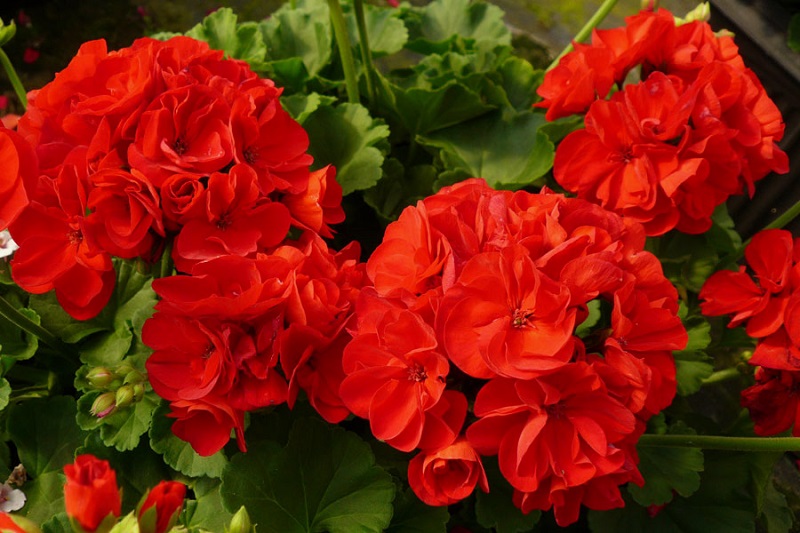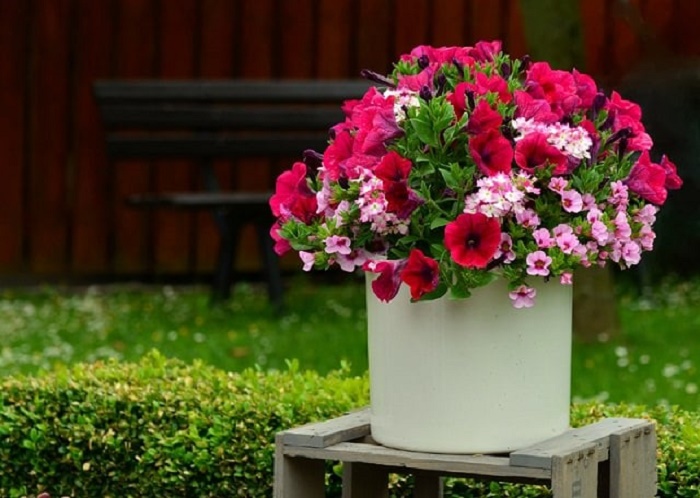The Pelargonium, along with Geranium, belongs to the family Geraniaceae. Both, count a large number of different species and varieties.
Pelargonium and Geranium, have in common, besides the immediate family, the shape of the fruit, which appears elongated and pointed. The Pelargoniums are a suffruticosa plant, the Geranium is a herbaceous. Their flowers, in both cases formed by five petals, are very different. In Pelargoni the corolla of a flower is formed from two different upper petals to shape, size and colors and three other increasingly less equal to each other. I have Geranium flowers with flat corolla, formed by equal petals, with color shades that can go from pink to purple, white to red, furrowed Read veins. Another distinctive feature of the two plants are the leaves, whole in Pelargoni, divided in Geranium.
The geranium is one of the most common plants vessel during the spring-summer season. Many have balconies or gardens adorned by abundant and colorful geranium blooms, which also come with fragrance particularly. They are often also used as a remedy against mosquitoes.
Below we will discuss the Pelargonium that commonly and erroneously also are known with the name of geraniums. Originating in southern Africa, they have spread rapidly throughout the world, because they are particularly valued as ornamental pot plants or garden but also for their ease of cultivation.

Geranium Care: Tips and important information
The Geranium leaves have a whole form, often with long petioles and veins that help to bring out their deep green color. The flowers are usually composed of five petals arranged in umbels of different colors white, pink, fuchsia, red, blue, purple, orange red and many others also varied. The varieties of geranium present on the market differ in the characteristics of the flower, the shape of the leaves of the plant and for the bearing, which can be erected or hanging. Based on these distinctive elements we could use the different varieties to create borders, flower beds, balcony box or flowering corners in our terraces or gardens. Being familiar with the varieties of geraniums help in their care, in the selection to be done to achieve the desired result.
The zonal geranium is particularly widespread in its many variants. Its scientific name is Pelargonium x hortorum. It has an upright bushy, bunches of flowers borne on long stems, contain many single flowers, from the many colors. The leaves have a meaty texture. They live very well in rich, moist soil but well drained, in sunny locations. Very common are varieties Maverick, Ringo, Bandit, Black Magic presents an interesting contrast of dark foliage and pink and white flowers. They may very well grow in pots on balconies or terraces, where flowers will offer the safe scenic impact.
The geranium “Imperial” has the characteristic of having a particularly vigorous growth. Its scientific name is Pelargonium grandiflorum. It has an upright habit, leaves with numerous darker veins, very generous in bloom, coloring the plant from May to August. The imperial geranium is distinguished from other varieties, precisely because of the presence of woody branches, but also for large particularly colorful flowers.
You may also like to read another article on GuangzhouFlowershop: Balcony flowers: Daisies in pots, the advice to cultivate!
The geranium scented, scientific name Pelargonium graveolens, has the characteristic of having the leaves with a scent that can have fruity notes of mandarin, lemon, apple, spices or other depending on the variety. The intense fragrance you appreciate more in the early morning when you lightly touch the leaves of the plant The scented geranium has large flowers and has an upright habit but less dense than the zonal. From the stems and leaves of the plant extract is an essential oil, Geranium Bourbon, with healing properties for dermatitis, fungal skin infections, anxiety, etc. The leaves are edible and, once dried, they can enter into the composition of potpourri. Its scent is commonly used in perfumery and cosmetics.
The geranium ivy simple, scientific name Pelargonium peltatum or hederifolium, is very common in the decoration of balconies, terraces, window sills. Grown in pots, especially resistant to adverse environmental conditions also sometimes, drought, air pollution, prefers sun exposure resistant even at low temperatures down to -5°, provided for shorter periods. The term ivy is associated with the particular shape of the leaves that is very similar to that of climbing plant.
The geranium ivy double derives from the intersection of Geranium simple and zonal geranium ivy. It has a double flower, the leaves have the same zonal geranium dark area but the plant is less robust and thick compared to the geranium ivy “simple”.

Geranium: Care and cultivation
Although geraniums do not require special care, should pay attention to important issues for the well being of the plant: watering, growing media, exposure to light.
The choice of the vessel in which to cultivate their geranium plant should be carried out with care. You will have to know the characteristics of selected varieties and the consequent vigor and development of the plant. They are usually used rectangular planters, boxes, bowls or round pots, preferably earthenware, which can be adapted to the balcony while the size of the vessel varies depending on the size of the plant, 20 cm for plants with more modest growth, up to 40 cm for those with the highest growth size.
In case you choose to cultivate potted geraniums, you will have to consider the living space for each plant, while the depth of the soil must be at least 20-25 centimeters.
Usually Geranium seeds can be planted in early spring. It ‘important to protect the seedlings from possible frosts to protect the young plants, which would be damaged by excessive temperature changes.
The geranium can also be easily reproduced by cuttings, without fear of any failures. Just remove a sprig of 5-10 centimeters plant, place the final part of the same in a solution of water and growth hormones and put it planted in an appropriate soil for cuttings. This done, and spent at least three or four weeks, you can transfer the plan and play in a vessel larger to then have a mature geranium.
The geranium is a plant suitable for balconies and terraces. It can grow well in full sun, although there are several varieties that need membrane areas. It is possible to understand if the geranium receives enough light simply by observing the plant, if it has an abundant flowering has light in quantity, otherwise will need to be shifted in the presence of more sun. It can be grown well in flower beds in the ground, as long as there is adequate soil, loose and rich in organic substance is.
Since plants that do well in climates with mild temperatures, geranium suffer particularly cold, with minor exceptions. As a result, in winter it is good to try to repair the plants in hot or cold greenhouses, taking away the plants from cold drafts.

Geranium and fertilization
To get rich and abundant blooms, we have made repeated and regular fertilizing from early spring for the duration of the entire growing cycle, until the arrival of autumn. They will be preferred organic-based fertilizers also liquid, to dissolve in water for the watering, to be administered at least every fifteen days.
The fertilization is useful to support the plant in different stages of growth, to bring it to obtain abundant blooms. It is important that the fertilizers used do not contain excessive nitrogen, because doing so favoritism the production of leaves and new vegetation and fewer flowers.
Geraniums and advice on pruning
For geraniums repaired in the greenhouse for the cold season, the pruning occurs at the beginning of the spring, eliminating dry leaves and branches decaying. During flowering it is appropriate to remove dry flowers and leaves to stimulate the plant to produce new ones and to get a compact shape for a healthy plant.
Like other plants also geraniums are subject to the attack of mites, fungi and aphids, pests that weaken the plant by sucking the sap. In this case the plant may have yellow leaves and sticky. We could make abundant wetting of the plant with water and mild soap to wash the honey dew from the leaves and use specific insecticides, preferably organic, or natural macerated to combat unwanted pests.
Tags: Geranium, Geranium Care



Leave a Reply